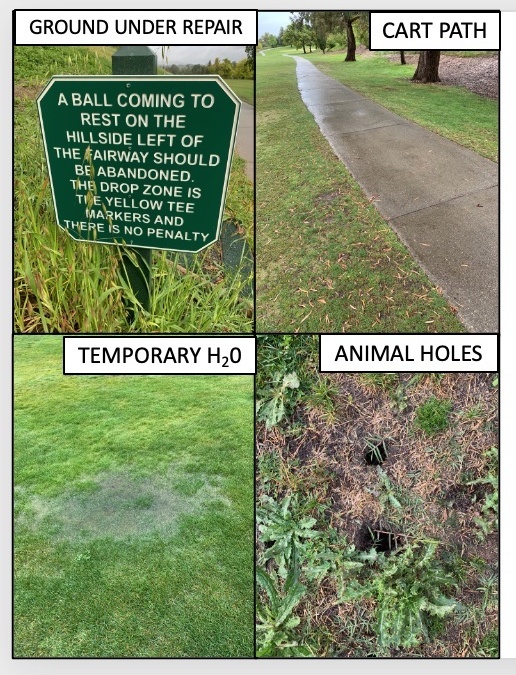by Joyce McCann – Rules Chair
What do a gopher hole, a water puddle, a cart path, and the hillside on Dollar #15 have in common?
By Joyce McCann, 18er Rules Chair
And the answer is ……. All of these seemingly quite different things are called Abnormal Course Conditions (Rule 16). They are examples of: Animal Holes (gopher hole), Temporary Water (water puddle), Immovable Obstructions (cart path), and Ground Under Repair (GUR) (Dollar #15 hillside).
These 4 categories are grouped together under the same moniker because, if your ball ends up in or on these, or if they interfere with your area of intended stance or intended swing, free relief is taken in the same way from all four conditions.
The first step is to find the Reference Point from which a relief area will be determined. The Reference Point is the Nearest Point of Complete Relief not nearer the hole, and is different depending on whether or not you can see the ball.
!. If you can see the ball (Rule 16.1b, the Nearest Point of Complete Relief is determined from wherever the ball is in the Abnormal Course Condition. For example, if the ball is visible in a puddle of water, the Nearest Point of Complete Relief will be the point outside the puddle that is nearest to the ball. Then, take relief by dropping a ball one club length from that point no nearer the hole.
2. If you can’t see the ball, the Nearest Point of Complete Relief is the estimated point where the ball crossed into the Abnormal Course Condition. The hillside on Dollar #15 is a great example. The entire hillside is a GUR No Play Zone. With the grasses currently blanketing the hillside, it is highly unlikely the ball will be visible. The Reference Point is the best estimate of where the ball crossed into GUR. Mark Heptig has determined that “the cart path should be used as the place where the ball crossed the margin of GUR”. Because errant drives can cross the margin of GUR very near the teeing areas on #15, it is not practical to follow normal relief procedures. Therefore, two Dropping Zones are used for relief. The correct procedure is to use the Dropping Zone that is closest to the Reference Point.
Abnormal Course Conditions are frequently encountered, so understanding that they are all dealt with in the same way will hopefully make it easier to remember the Rules.

